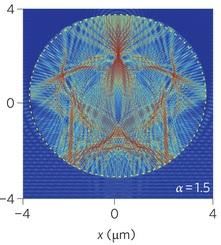Using AI to control energy for indoor agriculture
30 September 2024
Published online 12 May 2013

Devices such as solar cells, light-emitting diodes and lasers store energy in so-called optical resonators, which are cavities that trap light. Engineers finely tune the shape of these resonators to select for a particular light frequency more efficiently, usually in a symmetrical structure.
Now a team of engineers has built a prototype optical resonator with an irregular shape that encourages light rays to bounce around chaotically – that is, in an unpredictable manner, describing their work in Nature Photonics1.
A series of computer simulations demonstrated, in theory, that at least six times the amount of energy can be stored if the optical resonators are made with less symmetric geometries. In this case, the light rays bounce around in a more random manner and no single frequency is preferentially stored. Instead, all frequencies of light are stored equally well.
"The cost of building the resonator is exactly the same because you use the same amount of material, you just make it in a different shape and see an improvement in energy storage," says Andrea Fratalocchi, an electrical engineer and applied mathematician at the King Abdullah University of Science and Technology in Thuwal, Saudi Arabia.
The team then carried out a proof-of-principle experiment using optical resonators that were built from polystyrene. They showed that the amount of energy that can be stored within them is 12% higher if the microspheres are deformed than if they are perfect spheres. Fratalocchi is applying this to solar cells. "Another advantage is that deformed shapes are much easier to make in the lab than perfect ones," he adds.
doi:10.1038/nmiddleeast.2013.70
Stay connected: